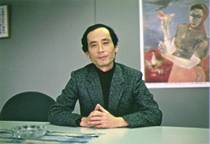

 |
 |
|
|
|
||||||||||||||||||||
Kohmoto Shinji |
|
 What kind of exhibition would you like "Yokohama 2001" to be? Kohmoto: First of all, I want it to be an exhibition that will be enjoyed by all visitors. I think it is important to fill the show with fun and fresh surprises, things that will naturally excite people's interest. However, the fun and surprises will not be the pre-programmed, uncomplicated stimuli provided by an amusement center. It would be great if we could create a site that visitors can move through with a sense of anticipation and excitement, where they can encounter the unknown and make new discoveries for themselves, as if they were wandering through a maze or a strange city without a map or a guide. And, in the end, I hope that they will gain something deeper than just having fun, that they will be stimulated to think on a deeper level, to look at everyday reality in entirely new ways. Many international exhibitions are being held recently throughout the world. What new contributions can be made by "Yokohama 2001"? Kohmoto: I don't think we can achieve what we want with a simplistic, superficial approach: a facile engagement with the discourse of globalization, effusive embracing of the new media or information technology, or a focus on stereotypical views of Japan or Asia. If we were distracted by these fashionable or superficial concerns, we would be left with an uninteresting variation of existing international exhibitions. This show would be nothing but a festival of reaffirmation of things we already know. In "Yokohama 2001", I think we need to present new ways of seeing, new ways of interpreting the world and society, and new possibilities for relating art to society that are unique to "Yokohama 2001", views that are different from those presented by other international exhibitions. This may be an overwhelming task, like introducing a new computer operating system that is completely different from the one already in use all over the world, like building a different kind of operating system based on questions that cannot be analyzed by an algorithm. However, I think it is extremely important to use "Yokohama 2001" to challenge established views. What will be the main features of this triennale? Kohmoto: The main purpose of the Yokohama 2001 is to introduce the latest international art trends here in Yokohama once every three years. Therefore, the most important thing about this show is the opportunity it provides to find out what the world's artists are thinking and what sorts of expression they are producing right now. We want to enable the largest possible number of people to gain knowledge of the diverse approaches, points of view, and ways of thinking employed by artists throughout the world by interacting with these artists and experiencing their works. Artists frequently interpret the everyday world that we take for granted in entirely unexpected ways and let us see new aspects of our lives and realities. Political, scientific, and technical issues will also be clarified in simple visual displays along with presentations of art and culture. We want to let as many people as possible encounter these diverse displays and directly experience the visual and intellectual excitement of "Yokohama 2001". What kind of message do you want to convey through this triennial exhibition? Kohmoto: I want people to realize how many things art can express about our society and culture and how it can stimulate our thinking. Art is not a practice removed from everyday life but something that is always close to ordinary sensibilities. At the same time, we need to learn to think about their everyday reality in new ways. This show is a step forward. It provides an entrance to an understanding of the art activities of our own day. I think it will give visitors an opportunity to encounter and think about things beyond their present understanding and think about themselves and others in new ways. What is most important for the success of such a big project? Kohmoto: It goes without saying that it is the broad-based support of the people of Yokohama, the site of the exhibition. It is especially important that the local people appreciate the significance of "Yokohama 2001" and do what is necessary to nurture it over the years, since it will not produce the immediate benefits that might be obtained from a large public works project. It is necessary to support the activities of artists even though there is no obvious connection to economic gain and to understand that the accumulated effect of the exhibition holds out great possibilities for the future of the region. With respect to this, I have no doubts about the foresight and capability of Yokohama. Another important thing is teamwork on the part of the organizers and responsible decision-making by the staff members working in different areas. Each individual must have the will to make responsible decisions and deal with the problems he or she faces, and it is necessary to have organizational flexibility and a spirit of teamwork that allows them to do this effectively. "Yokohama 2001" presents a challenge to artistic practice and to all of us to change our everyday lives little by little. |
|